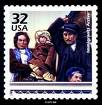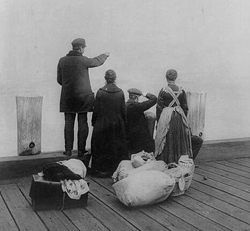| AMS 100: Introduction To American Identity and Culture |
III. Family Histories and Genealogy
A. Genealogy Libraries and Records

Most inquiries begin with a simple interview of any surviving relatives. Just a basic interview can be a valuable beginning for any study and provide future generations with information that is difficult to untangle with documents. Keep the interview informal and do not use recording devices. Try to just stick to a few initial questions about parents, grandparents and when/where relatives may have come to the United States. (Interview strategies and sample questions)
Family history research can be confusing and complex once you get beyond initial inquiry with family members. Research involves interviews, forms, records, and photos, can quickly become daunting. Getting organized is probably best by creating a Family History Notebook. Your objective is to have an organized notebook and not how much stuff you can cram into the notebook. For the class we begin with the Basic Data Sheet and a Five Generation Pedigree Chart. These and other forms can be filled out with preliminary interviews and transcription of information from private family records and documents. Some family records originally came from other sources and should always be checked for accuracy.

|
Family Records |
Source/Location |
| Family Bible | Home; Family Bibles have also been digitalized by the DAR |
| Birth, Marriage, Death, Graduation Certificates | Home, County Gov., Hospital, Churches |
| Church Records | Churches/Centers |
| Cemetery Records or Rubbings | Cemetery Office |
| Diaries | Home, Historical Societies |
| Correspondence | Home, Historical Societies |
| Military Records | US Govt, State Govt, County Seats, L. of Congress, etc. |
| School Transcripts | Schools |
| Photo Albums/Digital Archive | Home, Antique dealers, Historical Societies |
| Other Previous Research Documents/Notebooks | Home, internet |
Once initial interviews have been completed you need to visit a family history library and or internet sites. For the AMS 100 course this entails adding to your notebook forms and acquiring further records, documents and photos. Many researchers recommend that you keep a log book of library or internet site visits. The libraries include academic, public and private libraries and archives. Local historical archives are located in many counties throughout the U.S. at county seats, local libraries or in historical society or museum buildings. Often an historical building is rescued and the historical society puts in a museum and archive. We found one county in Kentucky with their historical museum and archive in an old jail. These local archives and libraries deal mainly with the pioneer families of the particular area.
|
LIBRARY/ARCHIVE |
Type/Affiliation |
Location |
| Carlsbad City: Genealogy Library at the Cole Library | SD Public/Serra | 1250 Carlsbad Village DR, Carlsbad, CA |
| Pioneer Room: Escondido Library | " " | 237 S. Kalmia ST., Escondido, CA |
| Family History Center (Main) | LDS | Salt Lake City, UT |
| San Diego Family History Center (also Escondido, Vista, Poway, etc.) | LDS | 4195 Camino del Rio South, San Diego, CA |
| San Diego Historical Society | SDCounty | Casa de Balboa, Balboa Park, San Diego, CA |
| Library of Congress | US Govt | Washington, DC |
| National Archives | US Govt | Washington D.C. |
| Ellis Island Passenger List | USHP | Ellis Island, NY |

Another source of information includes references, workshops, document forms and publications are genealogy societies. Here are a few:
| GENEALOGY SOCIETIES | LOCATION |
| National Genealogy Society | Arlington, Virginia |
| San Diego Genealogy Society | El Cajon, CA |
| The Computer Genealogy Society of San Diego | San Diego, CA |
| The North San Diego Genealogical Society | Carlsbad, CA |
| Escondido Genealogy Society | Escondido, CA |
Finally, the internet has become an excellent source of information (and some misinformation) that has become much better in the last few years. To avoid paying subscription fees take advantage of libraries that pay the fees, part of our tax dollar.
|
INTERNET LINKS FOR FAMILY HISTORY |
NOTES |
| Cyndi's List | Good source of other links |
| Ancestry and Root's Web; Heritage Quest; Family Search | All LDS affiliated, some good products and guidelines use Cole Lib. to avoid fees. Many sites default to ancestry.com |
| US Gen Web | has good links to state records |
| Rand Genealogy Club | 'Think Tank', but has good suggestions on sources |
| PBS: Faces of America | This is a new PBS program that includes family history research and genetics on celebrities |
B. Family History Notebook and Documentation
Your Family History Notebook will include genealogy forms, photos and documents (50 points) plus a 3-5 page individual narrative (50 points). Your notebook should be in at least a 1" 3-ring notebook with clear top loading sheet protectors. Your notebook will be evaluated by me but is yours to keep and is confidential. You should not drop off this assignment or leave it in the office. It will be turned in at the time of the final exam or earlier during office hours. Your notebook should consist of the following:
| Form #1:Basic Data Sheet | This is the first handout with basic individual/ cultural data. Generally, you are #1 in all subsequent charts |
| Form #2: Five Generation Chart(s) | 1-17 pedigree charts. Most of you will only have Chart #1 with the 5 generations of direct line ancestors. |
| Form #3: Ahnentafel Table | Basically a family tree showing paternal and maternal descent |
| Form #4: above part 2 | |
| Form #5: Family Group Sheet | Initially this should be your 'Nuclear' family: father/mother - blood/ adoptive plus siblings. Add a group sheet for each of your parents and grandparents. |
| Form #6: above part 2 | |
| Form #7 Research Log | Include any family interviews, records and publications pertaining to your family history. Enter them by the date of research. |
| Photos, Documentation, Records, | You should copy (no originals) of pertinent photos, documents and records of direct line ancestors on your pedigree chart. If you have too many just copy a sample of the most important. You, your parents and grandparents. |
| Individual Narrative | This is a separate 3-5 page narrative about yourself/ go to Individual Narrative |
Most of your forms use a numbering system with a strange German name called ahnentafel which just means "ancestor table". In the pedigree chart the first person (usually you or ego) is # 1. Father is # 2; mother is # 3. Males are even numbered and females are odd numbered. This numbering system should be used to include labeling photos and documents with name, birth and death dates and ahnentafel number.
C. Family History and Culture
The importance of family history includes the revelation and understanding of family roots and more recently investigating a genetic history. A family history consists primarily of events specific to ones family and parallel events in world history. This should produce a time/space continuum of when and where your family lived. Family culture portrays the lifestyle your ancestors experienced at various historical times. In simple terms this is a story or narrative about where your ancestors came from and when, where and how they came to America. Once in America where did you ancestors settle and what kind of activities did they engage in. These events can be summarized by where did move around in the United States. Since the United States is more of an open society with relatively unlimited opportunity, people tend to move around , so you might summarized the basic patterns of movement. If a job like the military, engineering and sales moved the family a lot this adds to a families' cultural experiences. The ethnicity, social networks, religion, education and vocation all contribute to the culture of that particular family.
Part of the story of ones family includes health. New research has completed the book of life, called the genome and now that book is slowly being interpreted or read. The American Medical Association (AMA) has launched a program for you determine a history of family health so that genetic anomolies that may cause future problems can be acted on. This of course is very controversial and involves many ethical and economic issues. Basically, you carry genetic information in your body cells (somatic cells) and these can trigger disease and the DNA can be modified by your environment. Also, in your sex cell you pass on genetic information to offspring. Your potential of somatic cells and DNA is your phenotype and your potential in your sex cells and DNA is your genotype. Specific loci of DNA in sex chromosomes, XX female and XY male provide specific and unique inheritance patterns that can only be passed through the paternal (male) line in the Y-DNA and the maternal (female) line in the mitichondria DNA (mt-DNA). This not only gives information on health history but allows genealogists to establish whether common names are derived from common ancestry. This research is based on known marker DNA (usually 12-74) and since the genome is not completely read the data and accuracy is improving all the time.
Copyright © S. J. Crouthamel